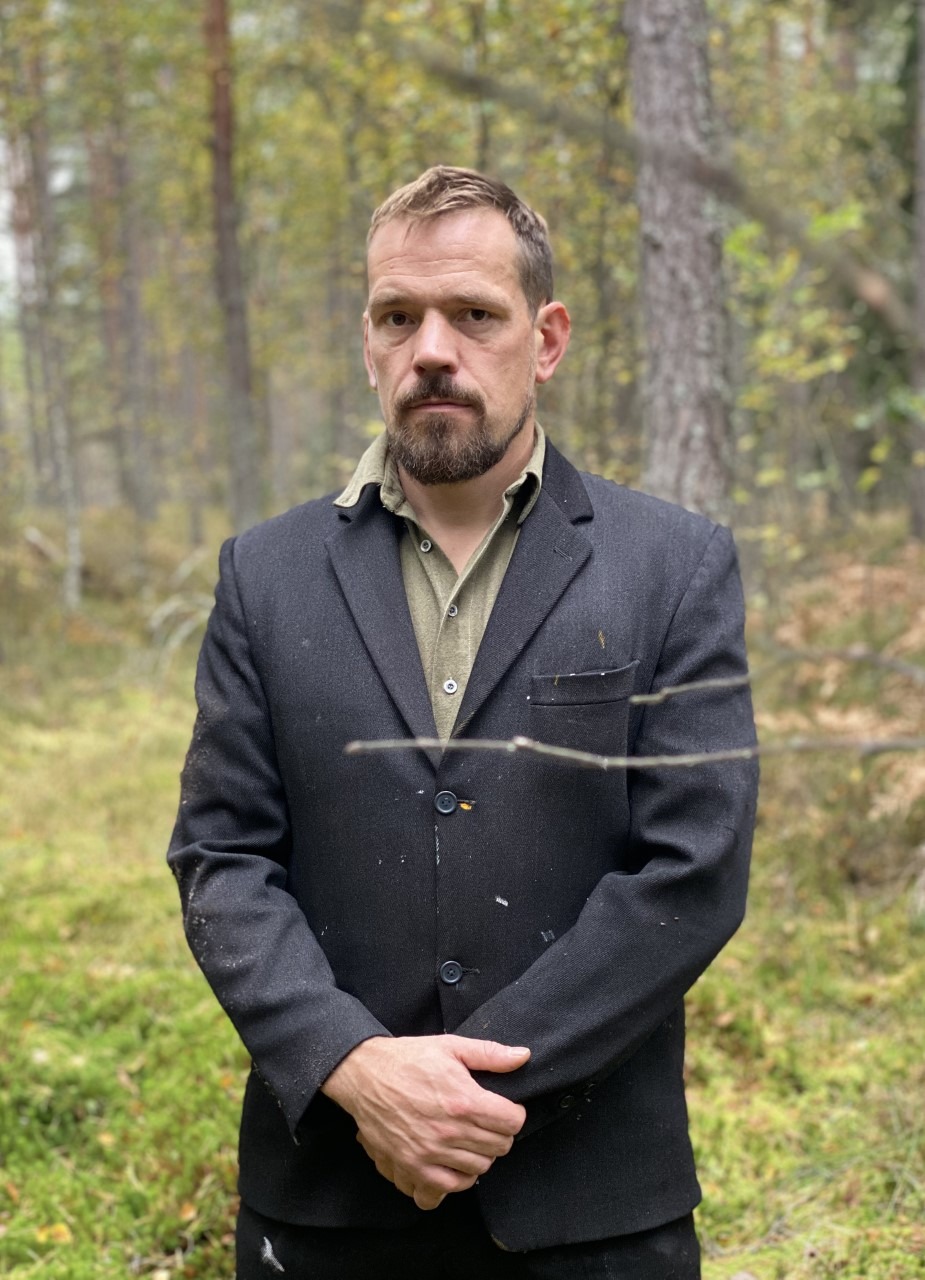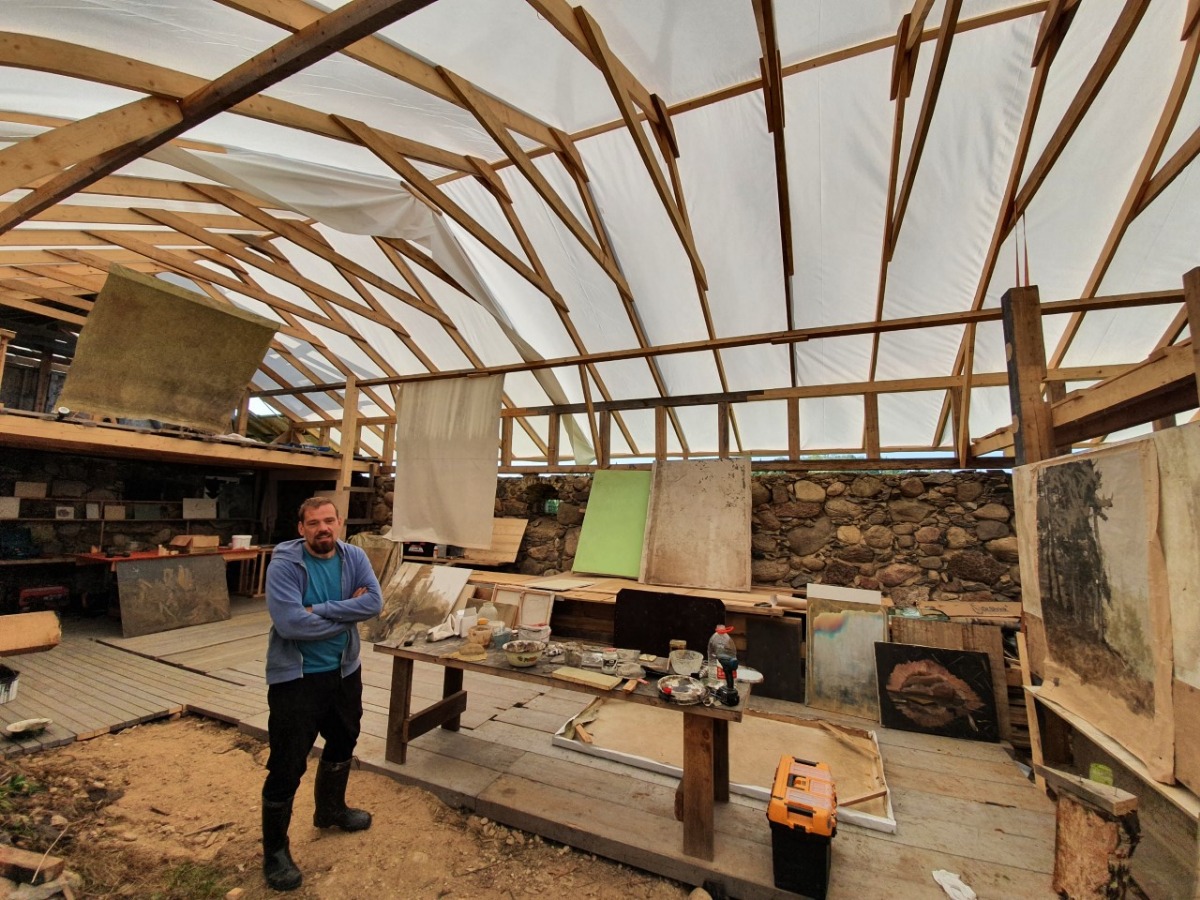
Painting and technical dreams
Ainārs Ērglis, Una Meistere
A conversation with Latvian artist Andris Eglītis
In July, in the wild nature between Dūķi and Jaundrusti (about a 1.5-hour drive from Riga), Latvian artist Andris Eglītis and a group of like-minded people began a processual outdoor exhibition titled Savvaļa (Wilderness). As a part of this project, works of art by more than a dozen artists are displayed on a property covering thirty-five hectares, where Eglītis’ own workshop is located as well. Among the artists are Eglītis himself, Raitis Hrolovičs, Kate Krolle and Reinis Bērziņš, Austris Mailītis, Katrīna Neiburga, Jānis Noviks, Kaspars Podnieks, Liene Rumpe, Kristīne Upīte, Linda Vidgorčika and others. A stroll around the exhibition can be done in a somewhat more urban manner but also complete with the mud, underbrush and waist-high grass that accompanies real nature. As Eglītis says, when one is out in nature and surrenders to it, “Nature and art will take care of everything as they see fit.”
Our conversation took place in Eglītis’ workshop at Savvaļa. The wind whistled through the wall-less, open space with extra gusto, and the tea in our cups cooled in half a minute, momentarily evoking an excursion in the Himalayas as the wilderness entered the conversation both empirically and physically.
Where did you get the idea for Savvaļa?
To be honest, I’ve had this idea for quite some time. I first applied for a grant from the State Culture Capital Foundation of Latvia three years ago and received a small amount to begin the project. I’ve had a link to this site for over a dozen years; I’ve associated it with somewhat naive, or maybe childish, thoughts about what it would be like to live in the wild. What would a person do outside of civilisation? What’s it like to live one on one with nature? And in some way, these thoughts have enticed me to work here and have provided a kind of impetus for everything here.
I very much like the fact that this place has the remains of a simple farmstead, that it wasn’t a grand estate of sorts, where, if you had a hundred souls working here, then you could focus on aesthetics. All around, you see evidence that a single family organised their life here, rolling around rocks in their own specific way, and so on.
And then there’s the question of how far do you need to go into the wilderness? And why? And, once you’re there, do you really need that hot shower or not? That’s the type of thoughts that go through my mind when I’m here. Art also operates in a completely different context here, as opposed to an exhibition hall in the city. And at some point I became interested in exhibiting something in this context as well. I also understood that I’m not interested in working solo, but that I wanted to invite others to participate here as well.
Linda Vigdorčika. Installation “Dab-nīca”, 2020. Photo: Madara Gritāne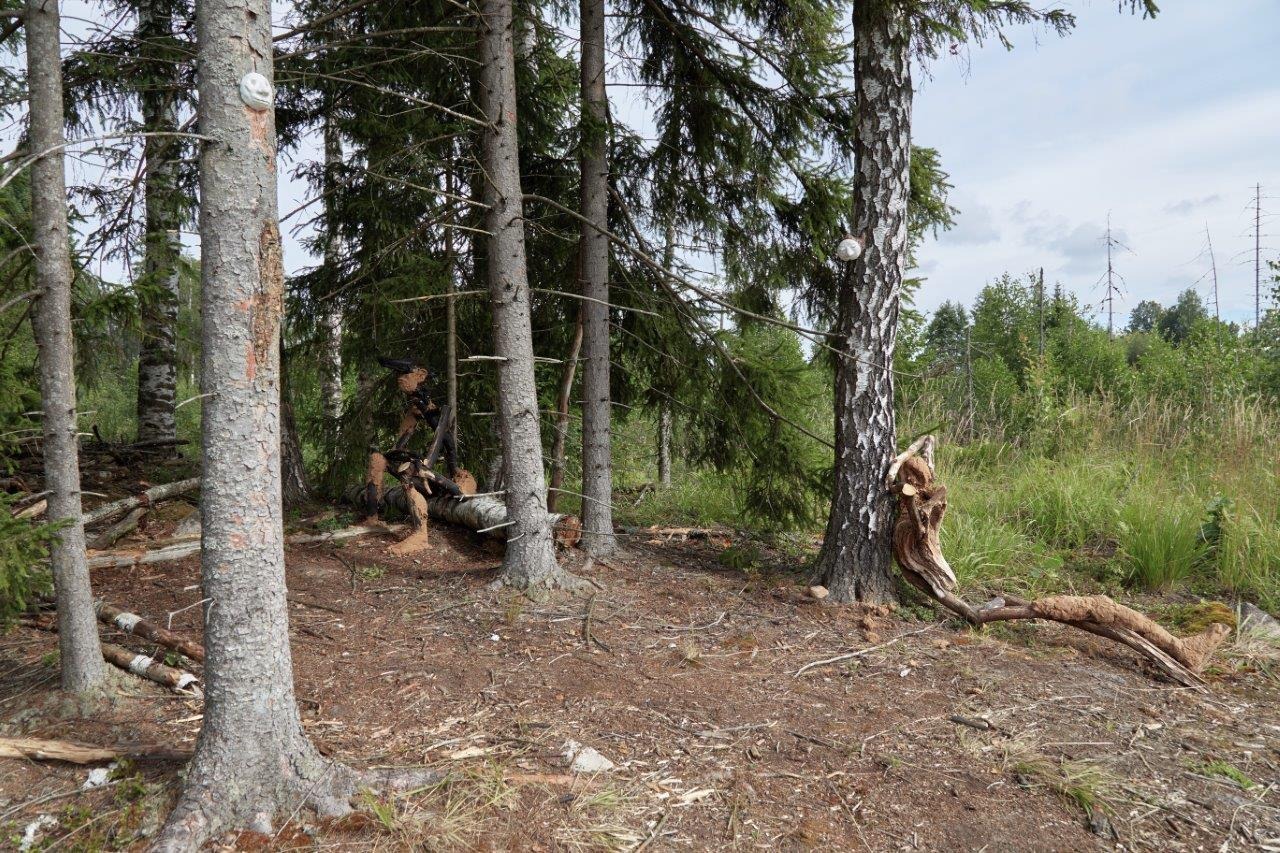
Was it a conscious decision to try to see how far you could go into the wilderness – find that Neanderthal in yourself, so to say, and become a part of nature again? Have you ever been on a similar quest before? Have you ever isolated yourself, say, for a week or two, just to get away from everything? Or is this something new?
For almost as long as I can remember, I’ve been interested in...maybe I wouldn’t call it nature, but the world beyond civilisation. In order to understand this civilisation and this culture. It’s probably a somewhat existential search – can a person even exist outside the network of civilisation? Do we need civilisation, and how much of it do we need? At the same time, when you’re out here, you suddenly realise how cool all of it is, the fact that there are roads and cars and warm, comfortable apartments.
I’m a doer. I’ve never simply just gone into the forest; I always need to start sawing or screwing something together.
What does “being in the wilderness” mean to us? Most people feel like they’re in the wilderness as soon as they’re without a phone connection and electricity. That’s actually the way civilisation touches us most closely. You can’t tune out, because it’s all around you. Your telephone rings, you have a gas stove instead of a campfire. You could reduce without all of that, too.
Another thing I’ve thought about: usually it’s the city dweller who goes to visit nature. He takes a look at nature and then quickly, quickly returns. Here, I think I’ve taken the opportunity to try to make myself at home in nature, to stay and live together with nature.
I’ve realised that you don’t need to seek out one correct way of living. You can live several different lives consecutively or parallel to each other. It’s great to spend three weeks here and then to go Paris or Brussels and appreciate that the world is very diverse.
Establishing a natural, organic, self-sufficient way of life hasn’t been my goal. But the more you try to exist self-sufficiently, the more you disassociate and shut yourself off from the world. I’ve realised that if you came and lived here for real, then you’d have very little time left for art, culture or whatever else. I don’t know if that’s good or bad, but I’m nevertheless interested in culture.
“Savvaļa”. Photo: Antons Georgs Grauds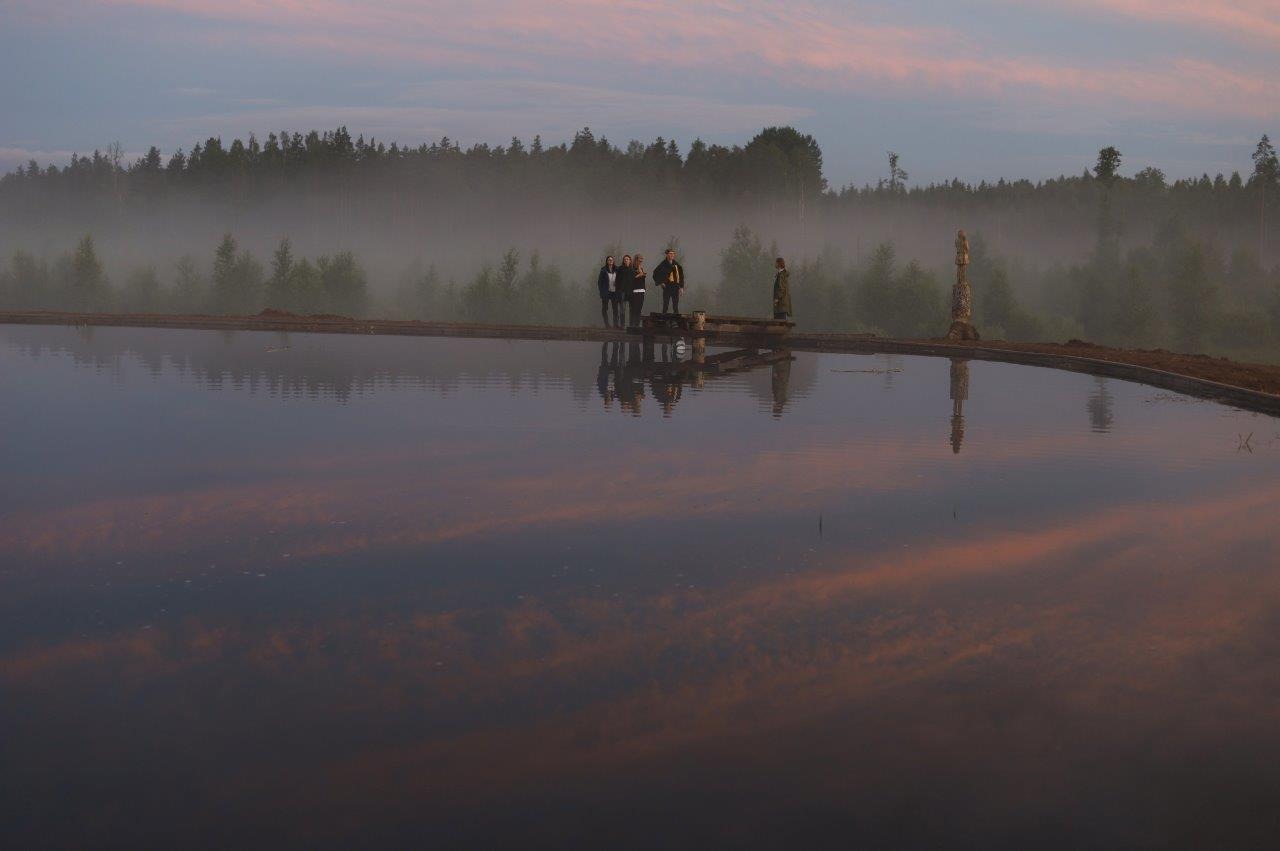
Does this experience of being outside of civilisation enrich you in some way?
This summer here, at Savvaļa, there were lots of conversations and simple experiences of being. Austris Mailītis and I talked about how, for Latvians, our identity is still quite close to nature. Even though we for the most part live in cities, when compared to the likes of New York of Paris, we still haven’t cut the umbilical cord.
And now, too, with Covid-19, we’re back to nature.
My parents live in Cēsis and have a garden in their yard. It’s interesting that throughout the Soviet era and even into the 1990s, everyone had a vegetable or flower garden (tulips and so on) next to or near their homes. Then it all got turned into lawn. And now, they’re tearing it all up and planting tomatoes and cucumbers again.
Summing up what you’ve said, there’s balance in synthesis – you can be in civilisation and out in nature at the same time.
The new normal is, for example, that you have a yacht but you also grow tomatoes. From the perspective of lifestyle and the attributes of status, that might seem contradictory. But it’s becoming an ever more common thing.
Just recently some people and I were talking about how people who live in the country – on farms with cows and potatoes and everything else – they’re the ones who feel safest in the present situation, because they know they’ll always have milk and potatoes to eat. In that sense – although that’s not the point I’m trying to make – rural people are the proudest. City dwellers are smug, but rural people are proud. That’s because they have a foundation under their feet. But of course, all of that’s just a flirtation and very conditional, considering our subsidised state of agriculture and all. In the end, at some point the farmer also ends up writing grant applications.
Ideas of re-enchantment are very popular now as well. If, up until the era of modernism, people considered themselves to be subject to, dependent on, or lesser than Nature or God, then modernism brought the idea that, with his capacity for understanding, man would now control the whole world and subject nature and everything else to himself. Our current situation has shown that that doesn’t work. That’s simply not the case. So gradually we’re returning to the idea that we’re not the ones who control everything; instead, we’re the ones who are subjected. And we need to learn to adapt and adjust and be dependent on uncontrollable powers.
Kate Krolle and Reinis Bērziņš. Sculpture “Return”, 2020. Photo: Andris Eglītis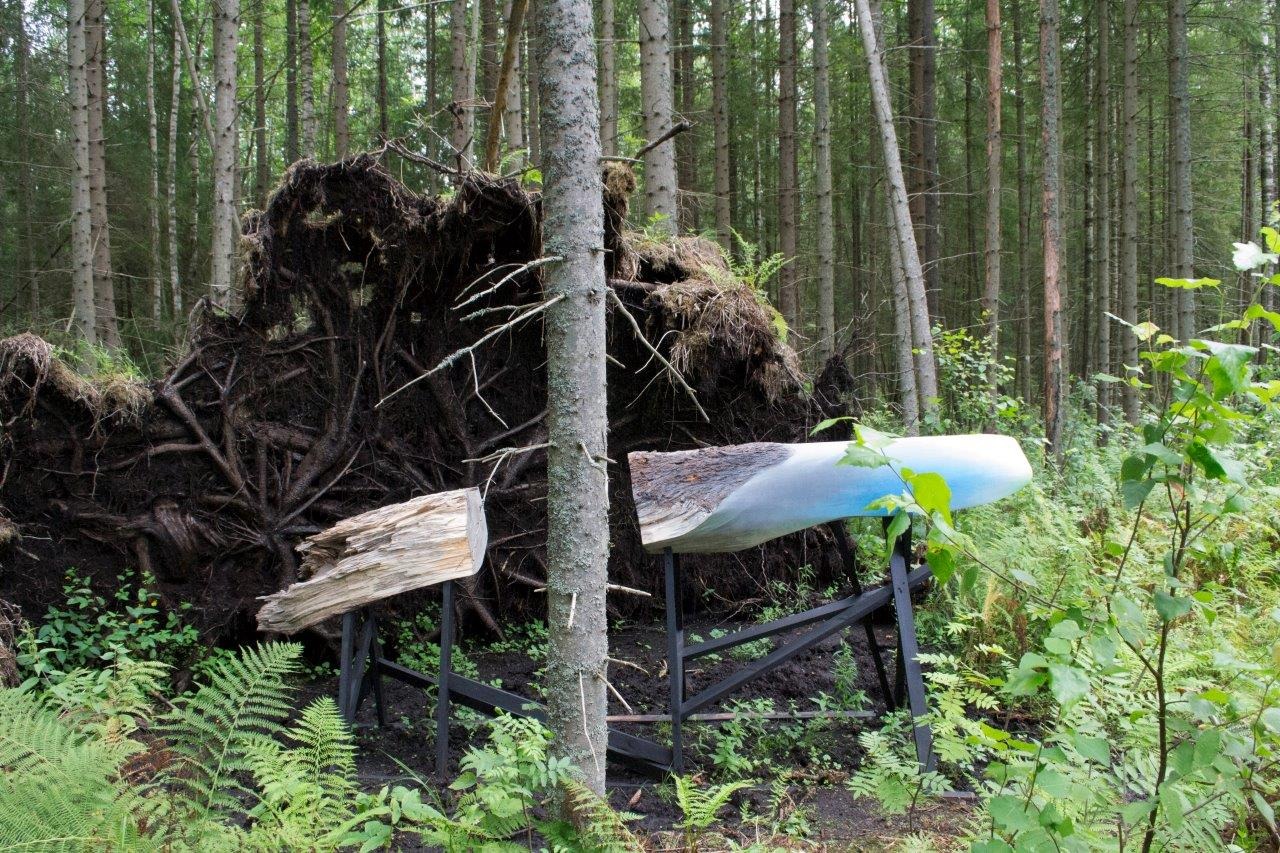
This juxtaposition of civilisation and nature has at least two sides to it. One is rational – this independent farmer grows all of his own food and has no need to worry. The other is a seeming sense of spiritual comfort – the mind. When the umbilical cord to nature is severed, you cross over to the modernist perspective in which we control everything with our minds. But at the moment when you realise that your mind doesn’t actually control anything, is nature the “escape point” where you can regain this spiritual balance?
Well, we’re a part of nature as well. In some unconscious way, we’re present in the rules of nature. After all, death, battle and cooperation all exist at the same time in the forest, too. Some things grow, others break or die; the natural process of things takes place, and it influences us as well, if only subconsciously.
One thing I suddenly understood here is why the Latvian word laiks (‘time’) has these two different meanings, both clock time and weather. Because, depending on what the weather is like, it affects how time flows for you. It’s completely different time. Time in an office takes on a completely different character than it does out here.
This year I had a vision of what my ideal life would be: I’d like to spend ¾ of my time outside the city and ¼ of my time in Riga. Three weeks out in the country and one week in Riga. On a schedule like that, the city suddenly seems really great, you can meet people, socialise...
Austris Mailītis. Kinetic installation “Wind watchers”, 2020. Photo: Andris Eglītis
You expressed concern that, if you moved permanently to the countryside, you might eventually cease creating art. Why? Does your creative energy come from civilisation? Do you know where it comes from?
No, but I know that, to a certain extent, art is a form of communication. Of course, it’s self-therapy and everything else, too. But in essence, if you make a work of art with the intention of showing it to someone, then that means you’re participating in a civilisational thought pattern. I’ve always tried to avoid extremism as an end in itself. In my opinion, the exchange of ideas is also important. In any case, I don’t want to say that everything here at Savvaļa is great and everything in the city is bad.
When you paint, can you pinpoint where your energy comes from? What’s the interconnection, the sense of engagement? Can you rationally explain what happens when you create?
There are very many levels, but one thing is clear: I can’t exist in the creative process all the time, because it’s too intense. Those paradise-and-hell conditions are so intense that it’s pretty impossible to live in them permanently. But I believe that one of the reasons why people still paint is that it’s an opportunity to enter states of existence that one ordinarily does not achieve. At least for me. Those are ideal moments, times when you feel you’re at one with truth... And then five minutes later you feel like everything is awful.
Andris Eglītis. Fountain “Sun panels, pump and tuft”, 2020. Photo: Andris Eglītis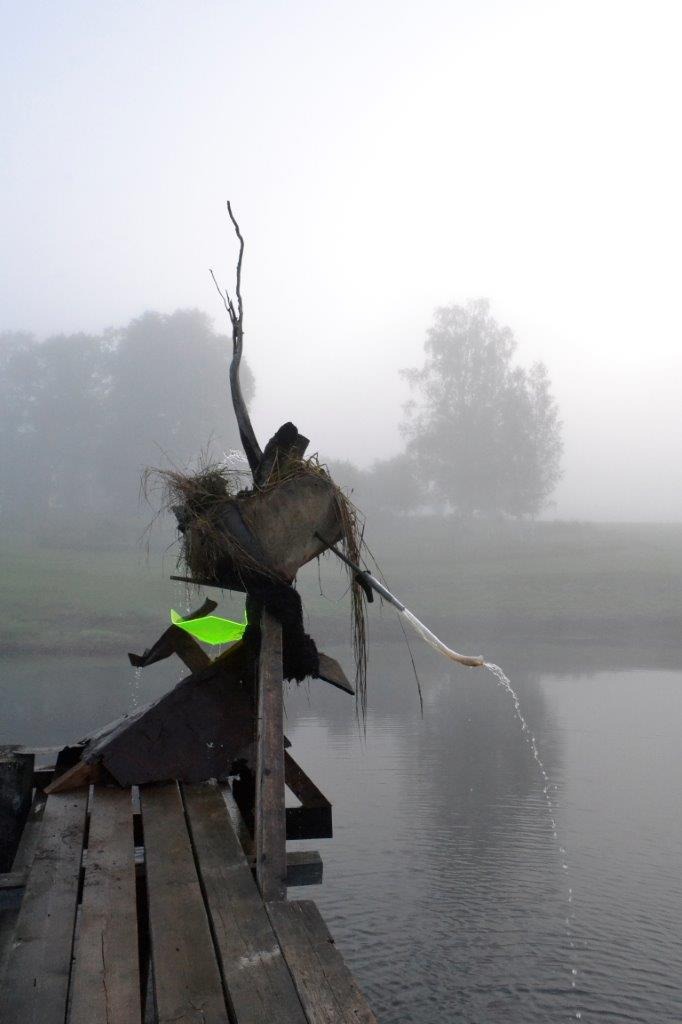
Maybe that’s why artists are often quite fragile beings. Drinking too much, losing their minds... Because, like you say, it’s impossible to endure a state like that for very long. Just like a normal person can’t meditate non-stop all day long, unless they’re a Buddhist monk. Is that similar in some sense? I’m not a painter, so I don’t know...
I haven’t analysed the process fully, but there is a kind of preparation stage during which you carry an idea around within yourself and it slowly matures. Then comes the active stage, which eventually empties you and at some point you realise that you’re just producing. You no longer have that drive.
On the other hand, of course, it’s kind of a self-generating process. If you’re inside it, then that’s where you get your ideas, energy and so on.
It surprised me when you said that you wouldn’t have time to create if you lived out in nature permanently. Theoretically, for an artist who has to set up an exhibition the following day, there are more sources of inspiration around here than there are in Riga.
I tend to say that I’m not interested in nature.
That’s an important nuance. I’ve always thought the opposite, that you are interested in nature.
I usually say that only in terms of visiting nature. I’m not interested in nature tourism or anything like that.
But living in nature? Have you painted anything new while you’ve been here?
It’s interesting, because last winter I worked at the studio in Riga, at my hangar on Ganību dambis. And now since spring I’ve worked both in Miķeltornis and here, and the works I’ve created in each place are completely different.
It’s all very primitive, though, because I gain inspiration from what’s around me. I paint what I see. That’s also one of the main reasons for this difference. But clearly, here I’m closer to nature, to some sort of wilderness.
Andris Eglītis. Sculpture “Luxury replica or the highest pines after the break”, 2008. Photo: Madara Gritāne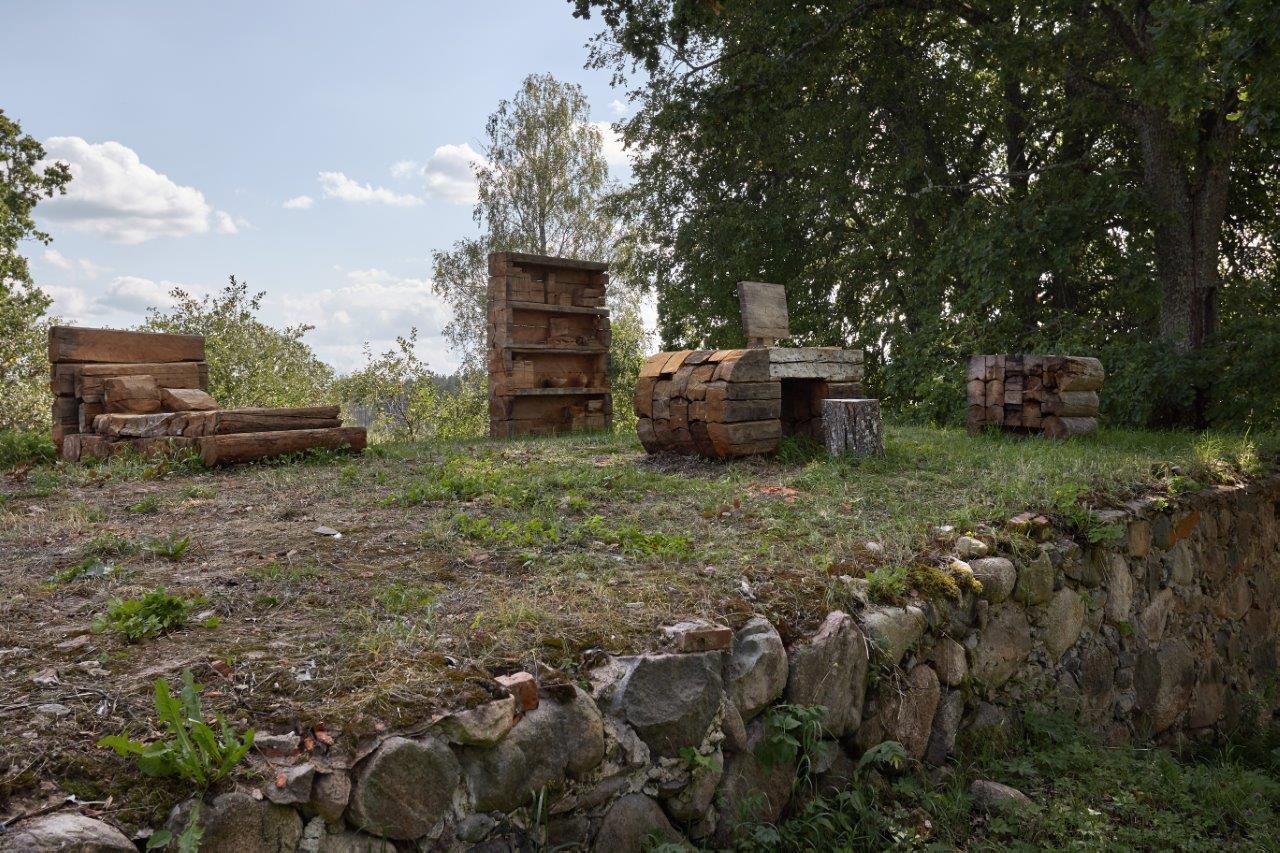
Are your thoughts different in nature as well?
That’s another aspect I’ve been paying attention to lately. We assume it’s normal for a person to change very quickly up until about age eighteen – while he or she grows from a child into an adult. But actually people change and grow throughout their lives. I like the comparison to a tree. At the beginning you have to fight for your place in the sun, and once you’ve done that, you don’t have to worry about it so much anymore because you’ve achieved a certain status. And the same goes for people. It’s a normal process of living.
You’re primarily a painter, but you’re also a fine craftsman who makes and creates things out of wood, thus channelling various ideas or energy. For example, for the Venice Biennale, you could have just made a sketch and had someone else build it. But clearly, the thrill of making it and nailing it together yourself is important to you. Is it not?
Precisely. I think that’s how a work develops and takes on energy. Because every work we make is not just an idea but also the physical-sensual experience of creating it. Just like with painting – it’s not enough to just have an idea, you need to paint it, too. That’s my methodology.
I think it was Heidegger who said: in order to know that you have seven cups on a table, you have to count them. In other words, in order for the world to exist for you, you have to assume an active stance towards it. And for me, this is a way of creating and understanding the world – I always have to be making and creating something, not so much observing it.
I think that’s also a widely known method of meditating – technical dreams – because it’s a clear and understandable world, you try to figure out how to make something, how to make it technically work.
Kristīne Upīte. Sculpture “Far away beaches”, 2019-2020. Photo: Madara Gritāne
How does that happen? Do you imagine something in your mind and immediately begin making it, as if surrendering to the process, or do you first make sketches and so on? What’s the process like?
Here there’s also an analogy to painting. Of course, for the Venice Biennale we planned and sketched and did technical calculations, because after all, it was a two-storey house we were making. But as with painting, where each stroke of the paintbrush contains some kind of meaning, in my case there’s also meaning in each board I saw. It’s both a technical and poetic meaning.
Like I said, my main impulse is painting. So, from this perspective, installations and sculpture are more like an expansion or auxiliary construction to help me eventually return to painting. In a sense, I think they also help me to remain with painting.
In the case of Savvaļa, for example, I’ve realised that as a platform it satisfies all of those needs and desires of mine that I can’t put into painting. If I only painted, I might feel like something was missing. I need those other means of expression as well.
Liene Rumpe. Installation “Sēņu kārta ir haotiska”, 2020. Photo: Madara Gritāne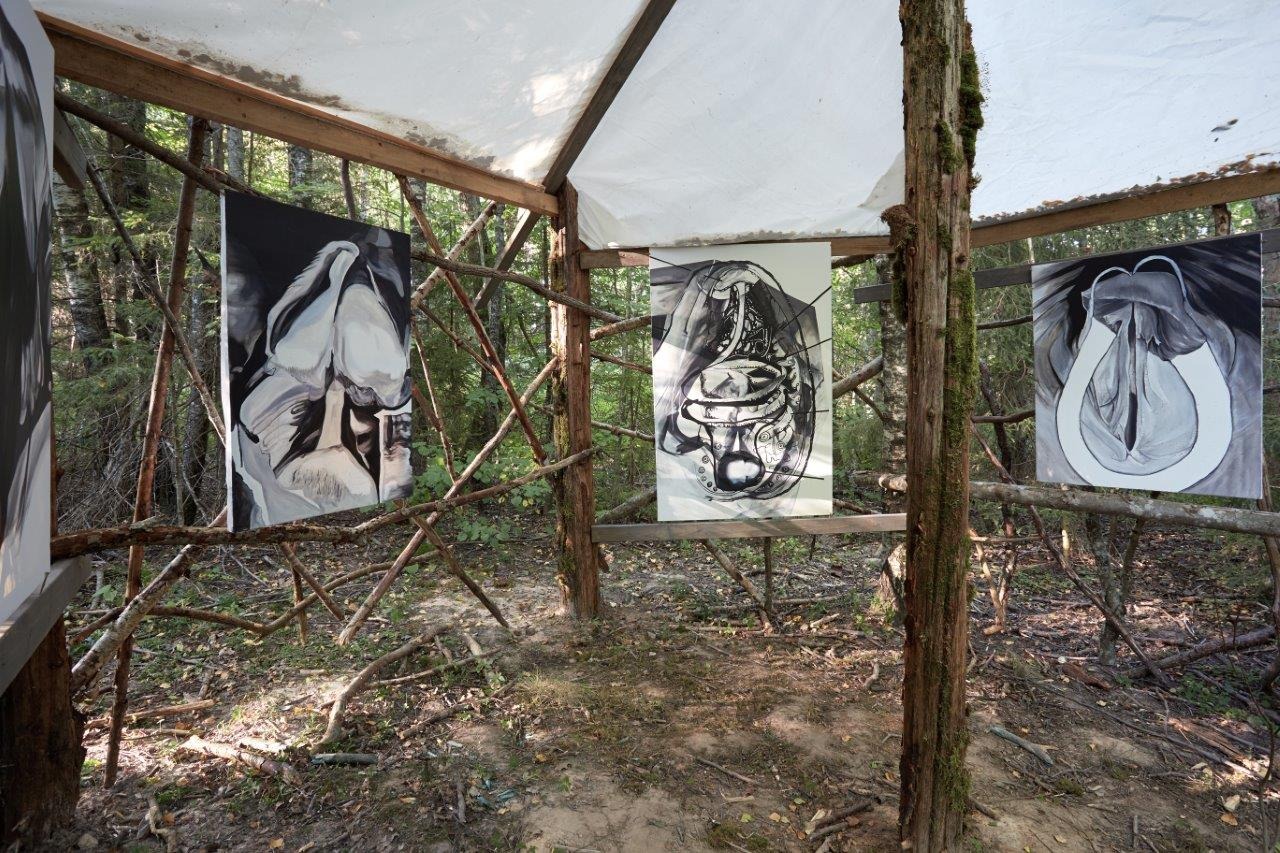
The work for the Venice Biennale was the first one that you created together with Katrīna Neiburga, wasn’t it? How does the creation process work when there are two of you? Is it like sex, when a real orgasm only happens when both partners connect to form a single whole? I realise that the creation process can’t usually be controlled, because you’ve got this connection going on then. But how does it take place when there are two people involved?
Yes, Venice was the first time Katrīna and I did something together. We had been side by side for quite some time before then, but each on our own. But since Venice we’ve returned to this duo format from time to time, which I believe is a wonderful way to create and do things, with this mutually supplementing effect.
But even before we began working together, we felt that there was a lot of understanding between us. And likewise in all of the big projects where there’s been a big team involved – Venice, the Coachella music festival, Kochi-Muziris Biennale, etc. – it’s very easy for us to not lose our core and initial idea, because it’s like we’re on the same wavelength. Like a two-headed dragon with a single personality – it has these seemingly different sides, but the mutual understanding is also very deep.
Each of us has a slightly different role: I’m the builder, and Katrīna creates the story and the video. So we don’t have to compete on the same territory, but we nevertheless connect and overlap.
There are things we as humans understand, and then there’s the apparently invisible part that we’re still unable to understand. Have you achieved some kind of clarity about these things, any answers, an understanding of your role in all of it? That is, are you still searching, or do you feel that you’ve more or less “found yourself”?
When I was reading Gurdjieff, it struck me – although I’ve already known this about myself for a long time – that the mind is a very slow and feeble instrument. It’s only in our modern, Western, rational society that we think the mind is the main thing, the definitive power, but it’s obvious that it isn’t. In essence, the human is an irrational being. It’s not like someone asks you about the meaning of life and you try to come up with a rational answer. But at the same time, we also need the mind. This is a process that’s revealed very well in the creation of art – to create art, you need a rational mind, but you also need the irrational side, an intuition of sorts.
So I guess I’d probably say that I feel like I’m on a kind of path and I can see maybe one step ahead of me but no more. And I simply try to be open, alert and see what the next step will be.
“Savvaļa”. Photo: Andris Eglītis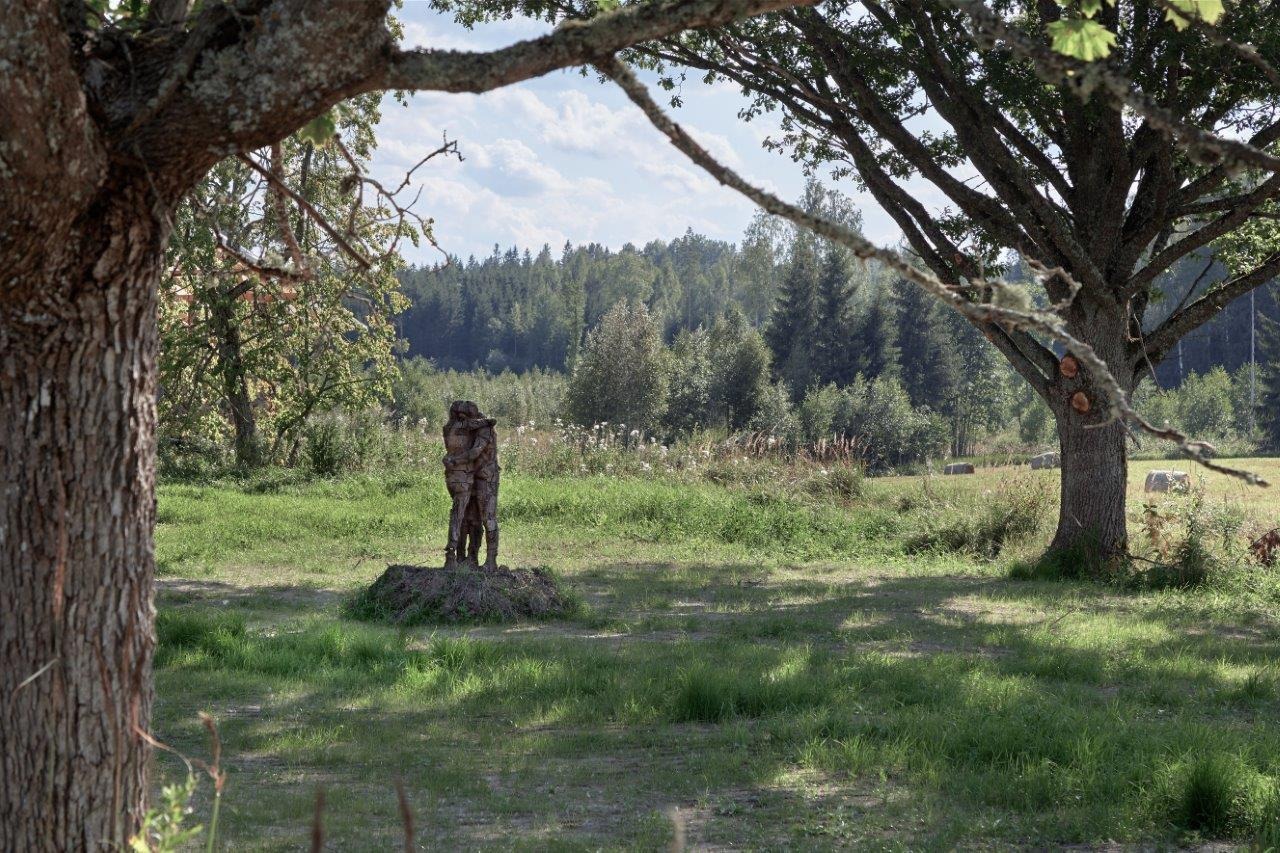
Do you trust that path? Are you comfortable with it? You’re not worried that three steps from now you’ll end up at a dead end, a quagmire?
Our psycho-emotional states are always churning up things, throwing us about. At one moment you feel good and comfortable, and the very next moment you feel desperate and hopeless. These feelings can change so quickly. The only thing I’m trying to learn to remember and accept is that we’re constantly being thrown around and none of these states are permanent or absolute. I’m trying to be more and more comfortable with myself.
Do you believe in anything?
I fully believe that human understanding is limited. The analogy is very simple. For example, a fly is walking around the rim of a cup. I assume the fly doesn’t know how that cup was made, what it was made for, etc. And just like that fly, we are limited in our ability to understand the higher laws of the universe. At the same time, we have this constant drive and desire to bang our heads up against this ceiling.
And at the moment when you’re creating and you’ve reached the truth for five minutes, have you broken through that ceiling?
At least there’s the illusion that I have.
Jānis Noviks. Installation “Industry beaver 17”, 2017-2020. Photo: Madara Gritāne 
Have you ever used any supplementary aids to reach that space beyond rational understanding, for example, have you experimented with psychedelics? If yes, have you reached a space where there were analogies with the creation process as such?
If you’re talking about ayahuasca, I’ve taken part in about three ceremonies, and I’ve always experienced a sort of super-clear state of mind. Everything seems so crystal clear, your mind becomes so lucid, you feel like you understand and can come up with answers to all sorts of questions that have occupied your mind, and in the end you’re overtaken by this unusual sense of happiness and euphoria. I’ve never gone to the really deep depths, deaths, rebirths, transformations or hallucinations, but it’s always been an empowering and crystal-clear thought process. I like being in that state of mind.
Eventually, though, it all grows over and you kind of forget about it. But another thing I’ve thought about in this regard – when you’re boozed up on alcohol, you also think you’ve arrived at the truth and you believe the conversations you have are so profound, when in fact they often sound pretty pitiful to anyone who’s sober. When you’re drunk, you also have this feeling of the truth. Or at least an illusion of it. It could just as well be an illusion that you get from ayahuasca or mushrooms.
The biggest difference between alcohol and so-called plant medicines seems to be that alcohol isn’t a teacher; alcohol pushes the mind to one side. Have you come to any deeper understandings through alcohol? I mean, in that sense, could you place alcohol on an equal footing with ayahuasca?
No, I’d probably say that alcohol is a social tool that lets conversations happen. Alcohol sometimes also works as a “restart tool”.
I’d say that plant medicines could probably also be considered meditative tools. They’re a shorter way of getting to the same place as you would with long-term meditation. Is that the same state of mind you’re in when you paint?
In a way, painting is kind of a tool for tripping.
Kaspars Podnieks. Photo from series Unusual Place, 2008-2010. Photo: Andris Eglītis
If we look at it from the perspective of quantum physics, everything that exists in nature and the universe is energy that has materialised in various forms. So, when you paint or use psychedelics, maybe you’re nearing this state of pure energy?
I suppose, but that energy is also released with the help of materials and chemistry. In the sense that the pure energy from painting is also always materialised in some way. It could just as well be the simple influence of chemical substances on the brain.
I guess my question was: can you compare the state of mind you’re in when you’re painting, when you’re fully in the moment, with the experience of ayahuasca? Is there a similarity between painting and the euphoria of ayahuasca?
Yes, definitely. It’s a simultaneous existence in both the material and the immaterial.
One of the biggest existential issues that all of us encounter sooner or later is death. Namely, we are born and we die. The realisation of this can be traumatic, but it can also be calming.
I’ve long boasted that I’m not afraid of dying at any moment. But I think that’s just a position I’ve taken. I makes it much easier to live.

Has anyone tried saying something to you only out of politeness? For example, saying something positive about your work, but it’s obvious to you that they’re just faking it?
I like looking at artwork knowing that there’s lots of different stuff encrypted in it. Meaning, all of your thoughts and attitudes, desires and values – it’s all in there. But the contradiction is in the fact that sometimes there are people who think really coherently and are really sensible in all things, but they paint very poorly, and vice versa. It’s some kind of complicated algorithm. The concept of talent is very unclear, too. It’s the presence of unarticulated abilities. Meaning, sometimes your intellect may be weak and lots of other things may be lousy as well, but somehow you possess the wisdom and intelligence, which then appears in your work.
I was recently at a gathering where a couple of local music groups played. Among the musicians was Klāvs Kalnačs of Židrūns. And there you see this huge difference – the way Klāvs sings and plays that guitar of his...it’s just so cool. But then you have groups whose genuine cries of the soul are just as real, just as impassioned, but you’re almost uncomfortable watching them. They lack the rest of those layers of intelligence. You see the person genuinely and wholeheartedly singing about love, everything seems right, but you’re a bit ashamed to listen to it. It’s an issue of how deeply the person who’s expressing it has perceived the message.
I used to purposefully avoid painting landscapes because all the older ladies would come up and say, “My, what a beautiful landscape!” And I’d think, “No, it’s not about that!” And I’d wonder how to avoid the fact that the paintings were so pretty, and that sometimes becomes harmful. So I’m always happy if someone has perceived a deeper layer in a work of art.
Maybe this ability to reach the source, to find that connection and engage with it, is one of the ways to define talent. You’ve been given this connection, but like you said yourself, it’s not really a gift. Maybe there are people who’d be prepared to return this gift, like, “Thanks, man, but I don’t need it, I want to be a normal person. I don’t want to go crazy.”
The only thing I lack is the ability to establish myself better in life. Everything else is OK.
What does establishing yourself in life mean to you?
In the material sense.
What do you lack in the material sense?
At the moment, while I’m sitting here in the sun and everything is fine, I don’t lack anything. But it also has to do with social standards and norms and that sort of thing.
More often than I’d like, what hinders this connection, this engagement, is worrying about where to get the dough to meet the family’s monthly budget.
“Savvaļa”. Photo: Madara Gritāne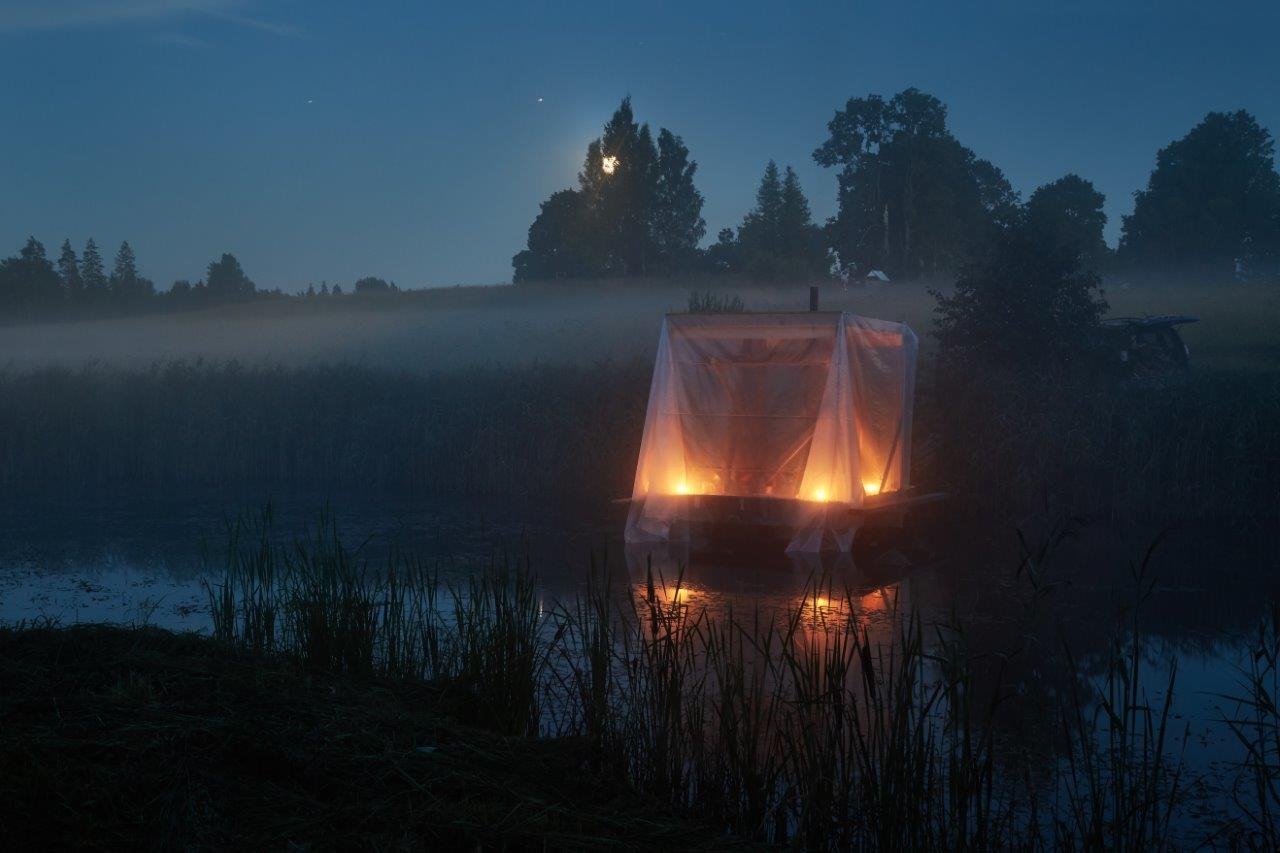
This is important, yes, but unfortunately it applies to all of us. But if we’re talking about changing reality, do you not have such experience?
If you’ll allow me, I’ll tell you a story. A believer goes to church and prays, “Please, please, God, let me win a million in the lottery.” In the end, God can’t stand it anymore and says, “Well, go and finally buy a ticket...”
Have you experienced absolute moments of crisis, when nothing is working in your favour?
I’ve always had long, long periods of preparation and then short, concentrated moments of creation. Here, too, I’ve been living here for two weeks, but I only got around to painting yesterday or the day before...right before I have to leave again. I usually mess around with some kind of materials, organising, laying the groundwork – I touch and feel and work with the materiality and wait for the moment when I finally want to create something.
It’s a recipe that I figured out already quite some time ago – for situations when I need to do something but don’t want to, when I just can’t get anything done. You feel the stress building up, and at some point you just need to accept the fact that, alright, I’m not going to do anything until the moment I really want to start. And as soon as you let go of the reins like that, that moment when you want to start arrives pretty quickly. So, instead of hanging around and tormenting yourself that you need to but can’t, you consciously don’t do anything until you want to.
Not pushing yourself into a deadlock – to a certain extent that can be applied to one’s whole life. The moment you let go, things start happening.
At the same time, though, I’ve always been sceptical about all of my thoughts and feelings. The other ditch you can drive yourself into, and which is quite prevalent, is a kind of obtuse self-confidence. So, the question is, how do you find the middle way? How do you be trusting, confident and rely on certain things, and at what moment do you become too self-confident? At what moment do you withdraw your healthy doubt and caution about the world?
When I was in China, one of the artists there had a book with various witty expressions, and I liked one of them a lot: “Trust only the person who doubts.” As soon as a person stops doubting and becomes overly confident, he becomes closed in a way. And that’s no longer good.
“Savvaļa”. Photo: Andris Eglītis
What are you painting now?
Right now I’m openly fumbling and feeling around a bit. Usually, when I arrive at a title, then the title starts to form a kind of frame, and the frame right now is “a few instances of the meeting of imagination and matter”. Technically speaking, right now I’m painting Savvaļa works.
Do you always need to come up with a title?
In the beginning, the process is quite open. For example, if an exhibition is approaching, I even try to delay coming up with a title for as long as I can, because specifying something can become limiting. It can narrow the process. But at some point you need to name it, because that lets you muster and mobilise. Besides, my works tend to be quite different from each other. So at some point I just need to understand what, of all the possibilities in the world, this is.
When you’ve finished a work, is it important for you that someone sees it? And is what they think about it important to you? Do you even want anyone to look at it and arrive at the same thoughts you had, or maybe completely different thoughts?
That’s also a very broad and diverse process. One thing is your own relationship to what you’ve created, the things only you yourself know. A different thing is the fact that how others perceive it to a certain extent influences your own perception of your work. For example, if someone says something or looks at it from a point of view that you hadn’t considered, that changes your own attitude towards the work.
Time is also very important. Actually, I’ve thought that, ideally, an artist would show a work to others only six months to a year after they’ve made it. Because by then you’ve kind of forgotten what your feelings were at that time, the thoughts that occupied your mind back then, and you can look at the art with some distance. There’s always some kind of contradiction or a relationship between your internal efforts, thoughts and feelings and the object that you’ve created. You can’t free yourself of that internal view, but after some time has passed you can look at it a little more neutrally.
People who say they only paint for themselves, I think that’s complete nonsense. If that were the case, you could just repaint the same canvas over and over again... When you create a work of art, I think there’s inevitably a thought in there that it will be shown to others.
I like how Kaspars Vanags put it – he talked about the evaluator, the critic sitting on your shoulder while you’re creating, and that critic is also the context. For example, when you create a work that you know will be shown in Latvia, in Riga, then the critic on your shoulder is completely different from the one who’s there if you’re painting with the knowledge that the result is going to be shown in Lithuania or India.
The context that’s somewhere within you always has quite a big influence on what you do, even if you don’t want to admit it.
Poetry reading at the “Savvaļa”. Photo: Marta Krivade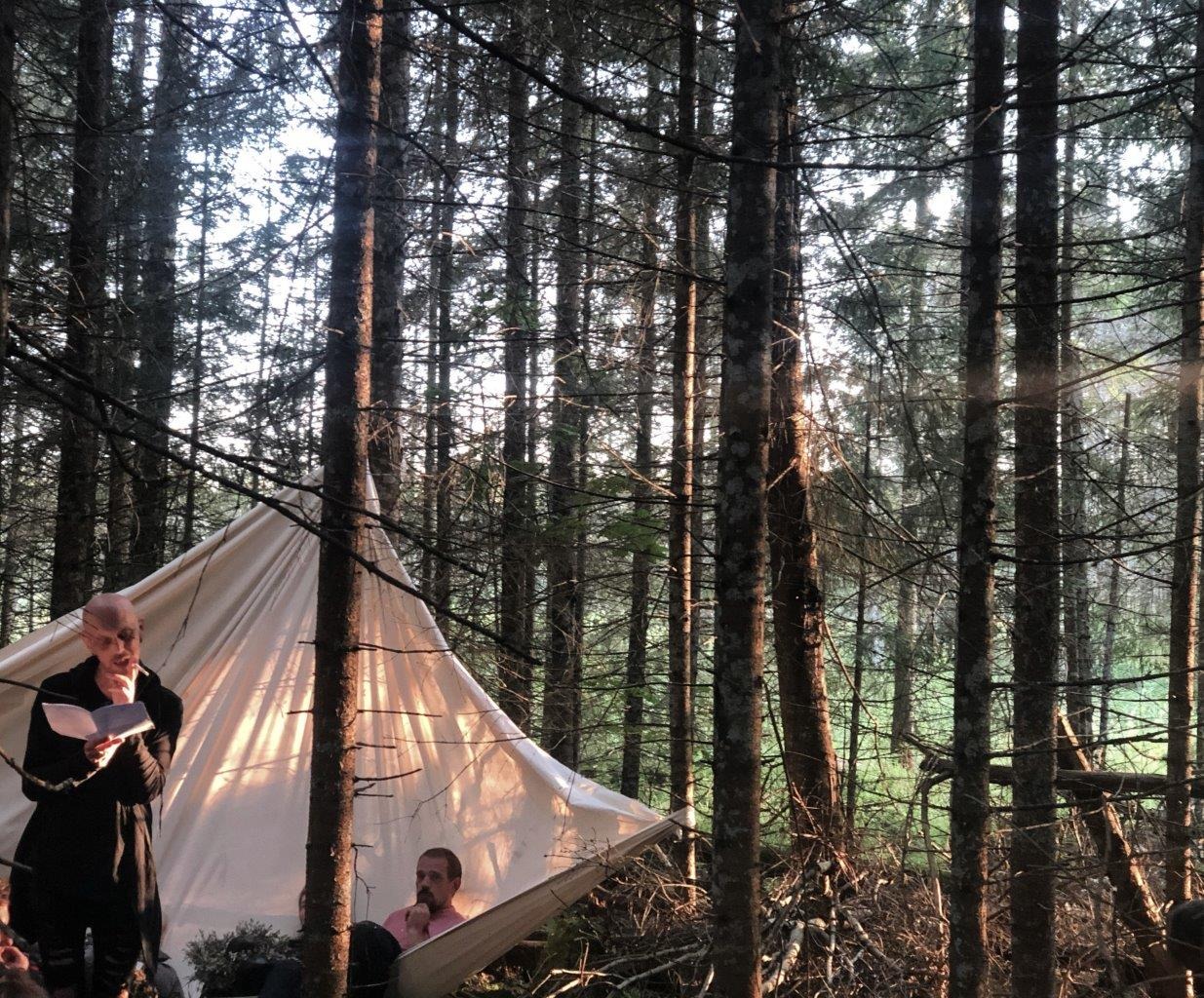
You could also call that the need, or the lack of a need, for feedback. On the one hand, you’re interested in feedback, but on the other hand, you allow viewers to engage on their own for at least a moment. To begin conversing with the art. Whether it’s you or a musician or some other artist, through your work you create an opportunity for people to experience the irrational. Because art is irrational; your painting has no functional meaning.
I once arrived at the idea that works of art are like a reminder or evidence of a different world, of a different state of things, and art lets you remember or enter that state of existence. There’s also that slightly strange contradiction in it, similarly to the case of a shaman or pastor – it’s a path towards knowledge or enlightenment, but it’s also a profession. But somehow everyone accepts that and comes to terms with it.
I don’t really see a contradiction there. Being a shaman or a pastor means to serve; serving as in giving to others. When you exhibit your work publicly, it’s like you’re an exhibitionist, but at the same time you also make the world a better place in some way. You agree that art makes the world better, don’t you? Whether it changes the world, though, is a different matter. In any case, you don’t show it just for the glory and the praise; you let people engage with it and see their own lives from a different perspective. Through art.
I think that, just like with shamans and others, it all comes as a package: serving others, the rational world, recognition, etc. It’s all in there together.
Imagine, for example, Shiva approaches you and says, “Andris, I give you the opportunity to decide. Either you create the most brilliant work of art in your life, one that you know is the absolute best you’ve ever achieved, but no one likes it and everyone says Eglītis has fallen flat on his face. Or else all you ever make is mediocre art, but everyone says Eglītis is a genius and they buy your work for lots of money; in your heart, however, you know it’s all just crap. Which do you choose?”
The first one, of course. But no one knows how honest my answer is! (Laughs.)
What’s interesting about this question is that the first answer is undoubtedly the right one. I think it’d be interesting to do a study and see if anyone chooses the second option.
“Savvaļa”. Photo: Andris Eglītis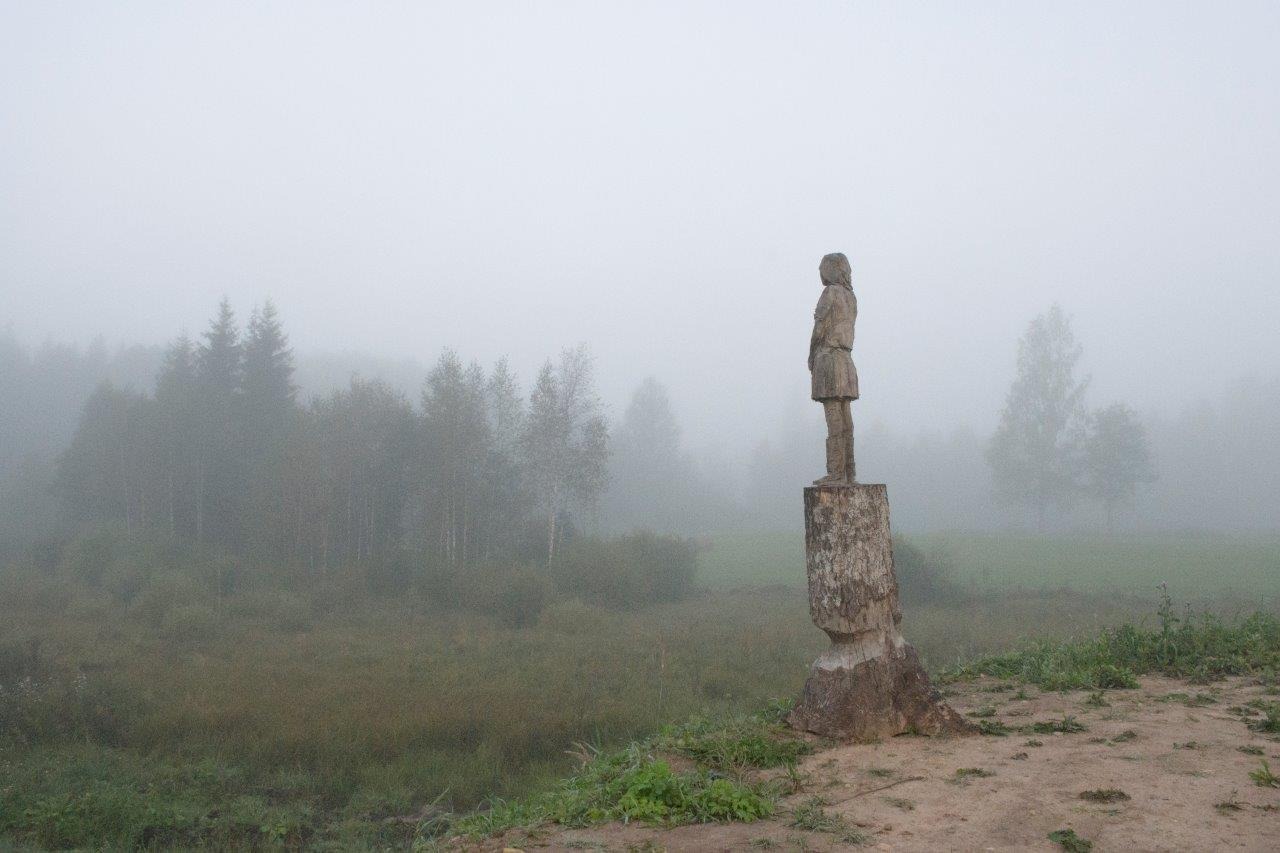
Do you think there’s any possibility that even just one person looking at your work of art will feel exactly what you felt when you painted it?
The answer is that I myself have a very unclear relationship with my works of art. I don’t know what I felt at that moment. Each work is born out of a dialogue of sorts. At first, I approach it with some kind of thought in mind, and then the work tells me, “No, it’s not going to be that. Maybe let’s try to move things around a different way.” In other words, that’s one of the reasons why painters keep painting – because they don’t know what’s going to happen. It’s a kind of miracle that emerges in the process. My artwork isn’t just a representation of my feelings; the works exist on their own. As something separate.
There are cases when I struggle and struggle and feel really good about a work – yes, now it’s so clear, this is going to be a great painting – but it’s not. It’s just not. And then there are cases that are the exact opposite – something suddenly emerges like a wonder, and you’re like, “Oh, wow!!!” You had no idea. So, I can’t really say that a painting is the result of something I’ve felt.
I suppose it’s possible that a work of art might elicit the same feelings in someone else as it does in me. But actually no, that’s not possible, because the other person didn’t create the work. There’s that aspect, too.
In essence, a work of art is like a being that opens up an opportunity for the viewer to arrive at the place where you arrived when you made it.
Often enough, when you’re creating a work of art, you have that sense of engagement, but the work doesn’t succeed. Having good engagement doesn’t necessarily mean that the work itself will also be good. The mechanism is more complicated than that.
But maybe unsuccessful works are also necessary?
Definitely. From my experience, I need to torture myself with something unsuccessful every once in a while in order that later something else might come to me very easily, like a gift.
I recently leafed through a book about how the masters of old made their paintings. A book of techniques. It also mentioned the familiar idea that it’s really bad if the artist’s trouble and anguish shows through in his work of art. And I guess it’s true, but then I wondered why. Is all the trouble the artist went through to create that painting unpleasant? I mean, it’s obvious that you often have to invest lots of hard work and so on to create a work of art, but the presence of those problems in the resulting painting interferes with it. There has to be a feeling that it all came easily to the artist. As if all by itself.
“Savvaļa”. Photo: Andris Eglītis
The fact that you don’t know what the result will be, that’s the same as in life. You don’t know what will come of your life, but you have to experience and enjoy it all anyway.
I’ve accepted the fact that being a painter is a big part of my identity, that I can’t separate it and say, “Here I’m a painter, and here I’m a person.” I’m a painter and that’s just the way it is. I simply spend an awful lot of time with painting inside of me, as a part of me. And it’s an essential part of my personality and my life. And I think that’s alright; I’m allowed to be like that.
Can one arrive at a sense of catharsis when looking at a painting?
Yes, I’ve wondered about that. I do believe one can experience catharsis from a painting. But there’s a different mechanism at work there. When you listen to music that’s here and now, you don’t experience catharsis. The catharsis that a painting leads to takes effect slowly and it’s long-lasting, like a reminder or a way of looking at the world that you maybe carry around with with you for a long time afterwards. It might not be a stunning high point at any particular point in time, but it’s something through which you can look at the world in a slightly different way. In a changed way.
Andris Eglītis